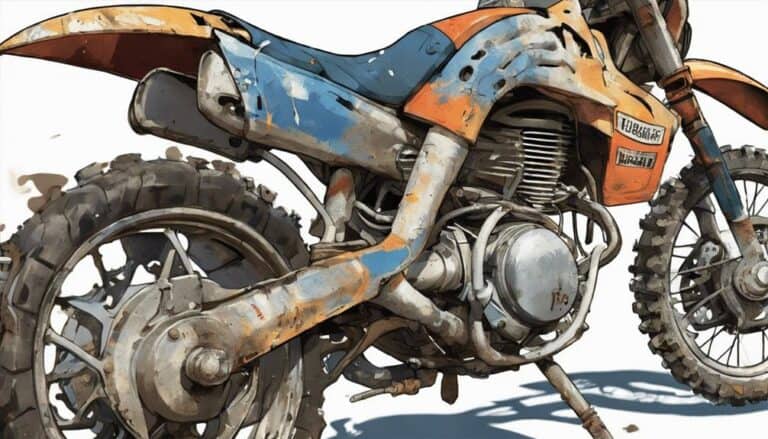You may not realize that a worn-out dirt bike cylinder can have a major impact on your bike's performance. Knowing when it's time for a replacement involves more than just a quick glance.
Understanding the subtle signs and symptoms of cylinder wear can save you from potential engine issues down the line. By paying attention to specific indicators and taking proactive measures, you can guarantee your dirt bike stays in top condition for longer.
Key Takeaways
- Look for visible signs of wear like grooves or scoring on cylinder walls.
- Check piston rings for wear, gaps, or scuffing to assess damage.
- Symptoms of worn cylinder walls include oil consumption, rough idling, and misfiring.
- Regular inspections are crucial to detect early wear and prevent further damage.
Signs of Cylinder Wear
How can you identify whether a dirt bike cylinder is worn out by looking for visible signs of wear such as grooves, scratches, or scoring on the cylinder walls? These signs of wear can indicate that the piston rings are no longer sealing properly against the cylinder walls, leading to a loss of compression.
As the piston moves up and down the cylinder during the engine's operation, any irregularities on the cylinder wall can cause damage to the piston rings and ultimately reduce the engine's performance. Excessive wear in the cylinder can also result in a decrease in compression levels, impacting the overall efficiency of the engine.
It's important to regularly inspect the cylinder walls for any visible signs of wear to prevent further damage to the piston and maintain the best compression levels. By addressing cylinder wear promptly, you can make sure that your dirt bike's engine operates at its peak performance and longevity.
Understanding Piston Damage
Detecting piston damage in a dirt bike engine involves closely examining for signs such as carbon build-up, uncertainty regarding cylinder wall lines, and concerns about cylinder markings. When inspecting a piston for wear, focus on the piston rings, piston wear, cylinder wall condition, and any markings present. Here is a table to help you understand the key aspects to look out for:
| Aspect | What to Look For |
|---|---|
| Piston Rings | Check for wear, gaps, or damage |
| Piston Wear | Look for scuffing, scratches, or uneven wear |
| Cylinder Wall | Inspect for scoring, scratches, or pitting |
| Worn Piston | Evaluate if piston material is worn or damaged |
| Service Manual | Refer to manual for specifications and guidance |
Carefully evaluating these factors in line with the service manual's instructions is essential for accurately determining the extent of piston damage and ensuring the dirt bike's engine functions at its best.
Symptoms of Worn Cylinder Walls
Inspecting worn cylinder walls on a dirt bike engine involves looking for specific symptoms that indicate potential issues with the cylinder's integrity. Excessive oil consumption and smoke from the exhaust are common signs of worn cylinder walls, as they allow oil to pass into the combustion chamber.
Loss of compression due to poor sealing between the piston rings and cylinder walls can lead to reduced engine power and performance. Rough idling, misfiring, or difficulty starting the engine may also point towards cylinder wall wear. Physical indicators such as visible scoring, scratches, or pitting on the cylinder walls are clear signs of deterioration.
Performing a leak down test can further confirm worn cylinder walls by detecting excessive air leakage past the piston rings. If you notice these symptoms, it's vital to address the issue promptly to prevent further damage to your dirt bike's engine.
Diagnosing Top End Wear
To properly diagnose top end wear on a dirt bike engine, focus on examining the presence of carbon build-up on the piston as an initial indicator of potential wear and tear. This can provide valuable insights into the condition of the piston and rings, helping you determine if they need replacement.
Additionally, pay attention to the cylinder head for any signs of damage or irregularities that may indicate wear in the engine's top end. Checking the ring groove and end gap can also offer clues about the overall health of the piston and rings in the engine of your dirt bike.
- Inspect the piston and rings for carbon build-up and signs of wear.
- Examine the cylinder head for any damage or irregularities.
- Measure the ring groove and end gap to assess the condition of the piston and rings accurately.
Importance of Regular Inspections
Regular inspections of the cylinder play an important role in detecting wear and preventing potential damage. When inspecting the cylinder of your dirt bike, look for signs such as ring ridge wear, aluminum exposure, and a tight ring gap. To assess wear, tap the cylinder lightly and listen for a ringing sound, indicating potential issues.
Additionally, check for marks where the end gap meets the cylinder wall, as this can signal wear on the piston rings. Monitoring the tightness of the ring gap is vital; if the rings fit too tightly, it may point to cylinder wear.
By conducting these regular inspections, you can catch wear early on and prevent further damage to the cylinder. Remember, a well-maintained cylinder is essential for the overall performance and longevity of your dirt bike's engine.
Stay proactive in your inspections to guarantee the top end of your bike remains in peak condition.
Conclusion
In summary, it's vital to regularly inspect your dirt bike cylinder for signs of wear to guarantee peak performance. Remember, proper maintenance can prevent costly repairs down the line.
Did you know that according to a study by Dirt Rider magazine, 75% of dirt bike engine failures are attributed to neglecting top end maintenance?
Stay proactive and attentive to your dirt bike's cylinder health to avoid potential issues in the future.

